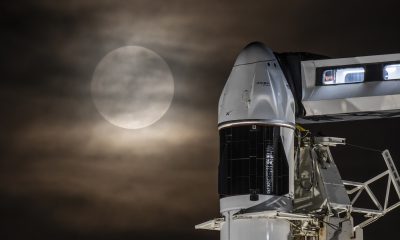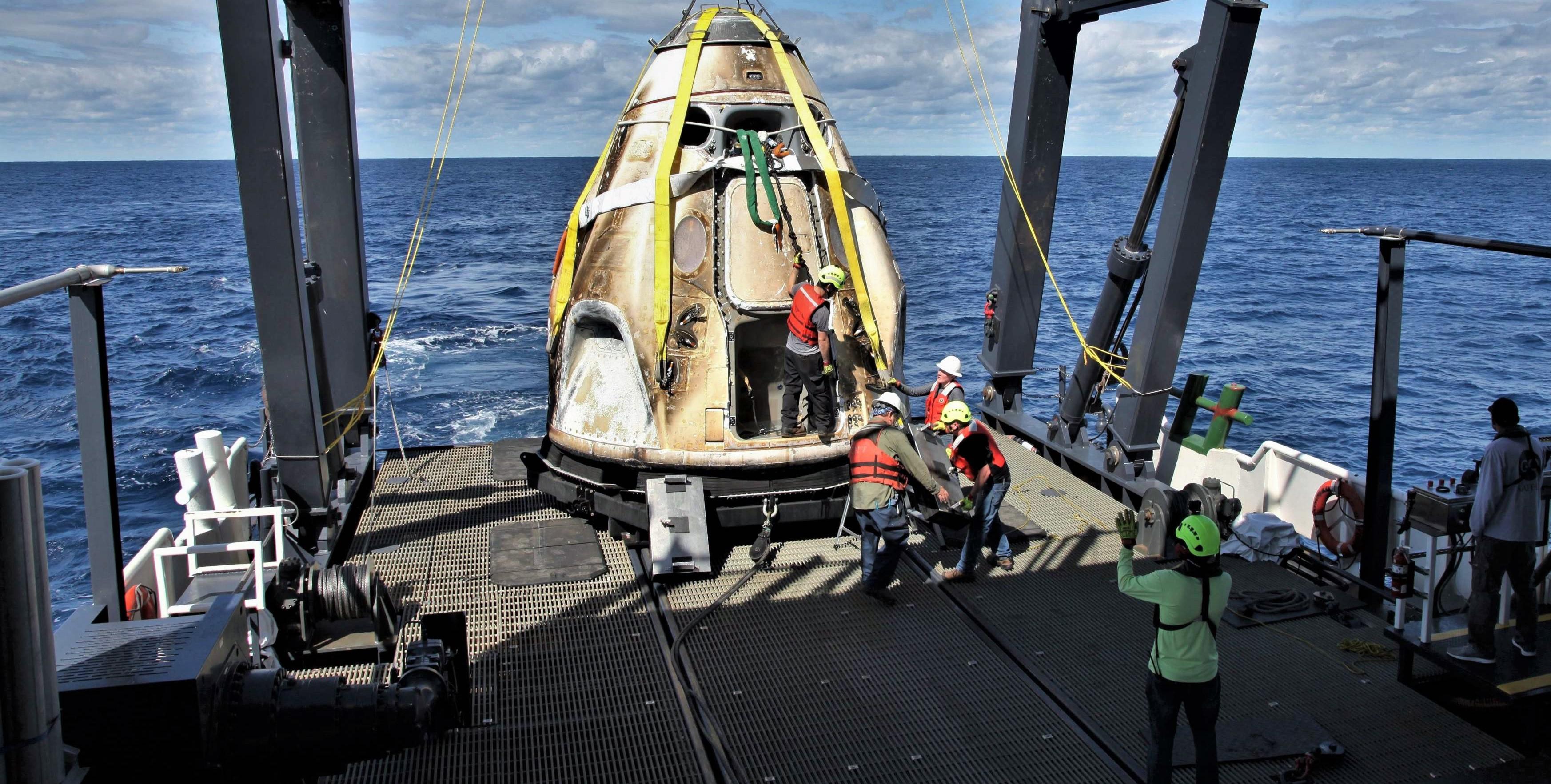

SpaceX
SpaceX’s Crew Dragon to launch astronauts in July, says Russian source
A source familiar with Russia’s aerospace industry recently informed state newspaper RIA Novosti that NASA has provided Russian space agency Roscosmos with an updated planning schedule for International Space Station (ISS) operations, including a preliminary target for SpaceX’s first Crew Dragon launch with astronauts aboard.
According to RIA’s source, NASA informed Roscosmos that the agency was tentatively planning for the launch of SpaceX’s Demonstration Mission 2 (DM-2) as early as July 25th, with the spacecraft departing the ISS, reentering the atmosphere, and safely returning astronauts Bob Behnken and Doug Hurley to Earth on August 5th. In a bizarre turn of events, Russian news agency TASS published a separate article barely 12 hours later, in which – once again – an anonymous space agency source told the outlet that “the [DM-2] launch of Crew Dragon is likely to be postponed to November”. For the time being, the reality likely stands somewhere in the middle.
While it’s hard not to jump to conclusions about the oddity of two wholly contradictory reports arising from similar sources in similar articles just half a day apart, it’s just as likely that the near-simultaneous publishing of both TASS and RIA stories is mainly a coincidence. At the same time, truth can be found in both comments made by the anonymous source(s), while they also offer a sort of best-case and worst-case scenario for the first crewed launch of SpaceX’s Crew Dragon spacecraft.
RIA began the series on March 22nd with a brief news blurb featuring one substantive quote from the aforementioned space industry source.
“The American side informed the Russian side that the launch of the [first crewed launch of] Dragon-2…to the ISS…is scheduled for July 25. The docking with the station is scheduled [to occur around one day later]. The separation from the ISS and return to Earth is expected on August 5,” the agency’s source said.
Put in a slightly different way, NASA informed Roscosmos that it had begun to loosely plan for the launch of SpaceX’s DM-2 no earlier than (NET) late July, much like NASA and SpaceX publicly announced that Crew Dragon’s DM-1 launch debut was scheduled NET January 17th as of early December 2018. DM-1’s actual debut wound up occurring on March 2nd, a delay of approximately six weeks. The cause(s) behind the discrepancy between NASA’s first serious planning date and the actual launch remains unknown but it’s safe to say that things took quite a bit longer than expected even after Crew Dragon and Falcon 9 were technically “go” for launch.
Although NASA and SpaceX now have the luxury of a vast cache of flight data and the practical experience derived from conducting Crew Dragon’s first – and nearly flawless – orbital launch and ISS rendezvous, Crew Dragon’s DM-2 mission remains an entirely different animal. Aside from requiring a number of significant hardware changes and introducing the visceral pressure of real human lives hanging in the balance, DM-2 will be a major first for the NASA after having spent the better part of eight years unable to launch its own astronauts into orbit.
A ‘race’ no more
Meanwhile, Boeing’s Starliner spacecraft – a companion to Crew Dragon under NASA’s Commercial Crew Program – has suffered multiple setbacks in 2019, reportedly pushing the vehicle’s uncrewed launch debut from April to NET August, a delay of at least four months. As a result, nothing short of severe anomalies during Crew Dragon hardware preparation and/or NASA’s reviews of DM-1 performance and DM-2 flight-readiness could prevent SpaceX from becoming the first commercial entity to build, launch, and operate a crewed spacecraft in the history of spaceflight.
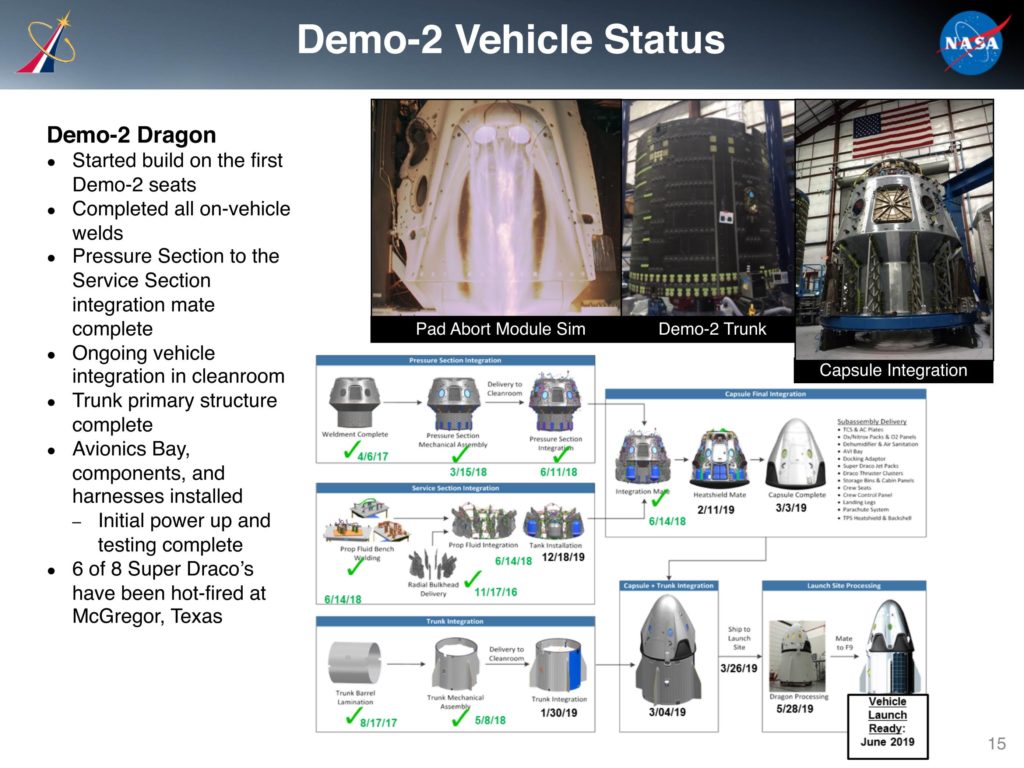

According to a December 2018 update provided during NASA’s quarterly Advisory Council meetings, the entirety of Crew Dragon DM-2’s manufacturing and integration may already be complete, with the capsule potentially heading to SpaceX’s Florida payload processing facilities later this week. NAC’s December 2018 dates did not, however, account for the DM-1 launch delays that shortly followed, plausibly impacting the completion of DM-2 integration and pad delivery to ensure that any potential anomalies experienced during Crew Dragon’s test flight could be resolved in Hawthorne, CA.
According to NASA and SpaceX, DM-2’s Crew Dragon will need to be retrofitted with thermal regulation hardware to prevent Draco thruster plumbing from freezing under a handful of specific conditions on orbit, as well as potential modifications to the craft’s parachute system and the installation of four windows instead of two. SpaceX will also need to install Crew Dragon’s first orbit-ready display and control hardware. Finally, SpaceX has opted to conduct an in-flight abort (IFA) test of Crew Dragon to verify that the spacecraft can safely carry astronauts to safety from the moment of launch to orbital insertion, a test that will have to be completed successfully and reviewed by NASA before the agency allows SpaceX to proceed with DM-2.

All of the above tasks – including major agency-wide reviews of Crew Dragon’s performance during its DM-1 debut – must be completed before SpaceX will be permitted to launch astronauts to the ISS, all of which inherently add some level of uncertainty to DM-2’s practical launch schedule. If all reviews and modifications proceed flawlessly, including a perfect in-flight abort test as early as late June, it’s possible that SpaceX and NASA could be prepared to launch Crew Dragon once more by the end of July.
In reality, it’s extremely unlikely that everything will proceed perfectly, as evidenced by the drawn-out process required for NASA and SpaceX to eventually reach flight-readiness prior to DM-1. If a significant number of challenges arise over the next few months of reviews and work, it’s not out of the question for DM-2’s launch to slip to Q4 2019 or Q1 2020. Splitting the difference, it would be safest to bet that Crew Dragon will lift off with astronauts aboard no earlier than August or September. Regardless, a great many exciting milestones are soon to come for SpaceX’s first human spaceflight program. Stay tuned as SpaceX prepares to ship the second flightworthy Crew Dragon to Florida.
Check out Teslarati’s Marketplace! We offer Tesla accessories, including for the Tesla Cybertruck and Tesla Model 3.
News
SpaceX launches Ax-4 mission to the ISS with international crew
The SpaceX Falcon 9 launched Axiom’s Ax-4 mission to ISS. Ax-4 crew will conduct 60+ science experiments during a 14-day stay on the ISS.
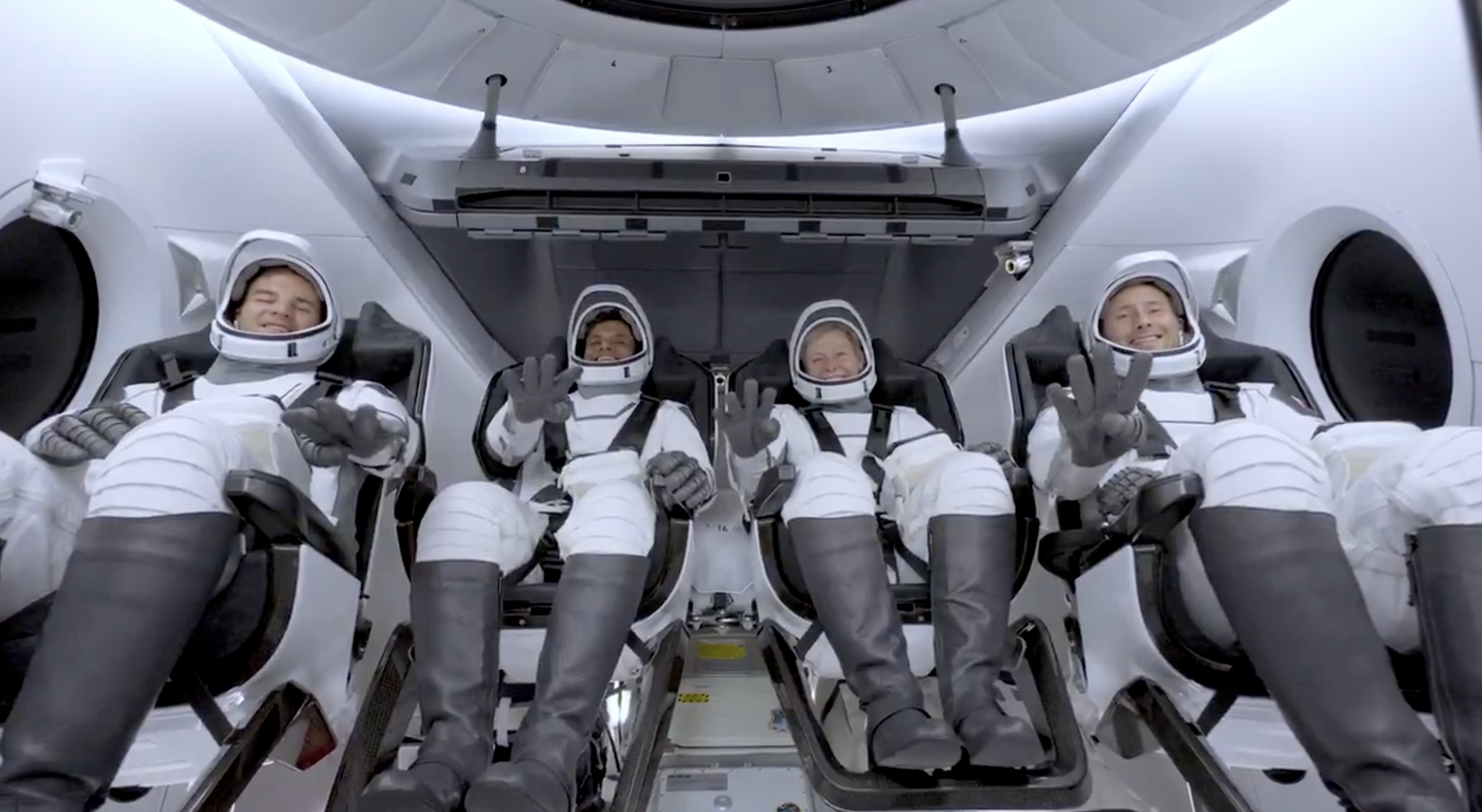
SpaceX launched the Falcon 9 rocket kickstarting Axiom Space’s Ax-4 mission to the International Space Station (ISS). Axiom’s Ax-4 mission is led by a historic international crew and lifted off from Kennedy Space Center’s Launch Complex 39A at 2:31 a.m. ET on June 25, 2025.
The Ax-4 crew is set to dock with the ISS around 7 a.m. ET on Thursday, June 26, 2025. Axiom Space, a Houston-based commercial space company, coordinated the mission with SpaceX for transportation and NASA for ISS access, with support from the European Space Agency and the astronauts’ governments.
The Ax-4 mission marks a milestone in global space collaboration. The Ax-4 crew, commanded by U.S. astronaut Peggy Whitson, includes Shubhanshu Shukla from India as the pilot, alongside mission specialists Sławosz Uznański-Wiśniewski from Poland and Tibor Kapu from Hungary.
“The trip marks the return to human spaceflight for those countries — their first government-sponsored flights in more than 40 years,” Axiom noted.
Shukla’s participation aligns with India’s Gaganyaan program planned for 2027. He is the first Indian astronaut to visit the ISS since Rakesh Sharma in 1984.
Axiom’s Ax-4 mission marks SpaceX’s 18th human spaceflight. The mission employs a Crew Dragon capsule atop a Falcon 9 rocket, designed with a launch escape system and “two-fault tolerant” for enhanced safety. The Axiom mission faced a few delays due to weather, a Falcon 9 leak, and an ISS Zvezda module leak investigation by NASA and Roscosmos before the recent successful launch.
As the crew prepares to execute its scientific objectives, SpaceX’s Ax-4 mission paves the way for a new era of inclusive space research, inspiring future generations and solidifying collaborative ties in the cosmos. During the Ax-4 crew’s 14-day stay in the ISS, the astronauts will conduct nearly 60 experiments.
“We’ll be conducting research that spans biology, material, and physical sciences as well as technology demonstrations,” said Whitson. “We’ll also be engaging with students around the world, sharing our experience and inspiring the next generation of explorers.”
SpaceX’s Ax-4 mission highlights Axiom’s role in advancing commercial spaceflight and fostering international partnerships. The mission strengthens global space exploration efforts by enabling historic spaceflight returns for India, Poland, and Hungary.
News
Starlink Cellular’s T-Mobile service to grow with third-party app data
From Oct 2025, T-Satellite will enable third-party apps in dead zones! WhatsApp, X, AccuWeather + more coming soon.

Starlink Cellular’s T-Mobile service will expand with third-party app data support starting in October, enhancing connectivity in cellular dead zones.
T-Mobile’s T-Satellite, supported by Starlink, launches officially on July 23. Following its launch, T-Mobile’s Starlink Cellular service will enable data access for third-party apps like WhatsApp, X, Google, Apple, AccuWeather, and AllTrails on October 1, 2025.
T-Mobile’s Starlink Cellular is currently in free beta. T-Satellite will add MMS support for Android phones on July 23, with iPhone support to follow. MMS support allows users to send images and audio clips alongside texts. By October, T-Mobile will extend emergency texting to all mobile users with compatible phones, beyond just T-Mobile customers, building on its existing 911 texting capability. The carrier also provides developer tools to help app makers integrate their software with T-Satellite’s data service, with plans to grow the supported app list.
T-Mobile announced these updates during an event celebrating an Ookla award naming it the best U.S. phone network, a remarkable turnaround from its last-place ranking a decade ago.
“We not only dream about going from worst to best, we actually do it. We’re a good two years ahead of Verizon and AT&T, and I believe that lead is going to grow,” said T-Mobile’s Chief Operating Officer Srini Gopalan.
T-Mobile unveiled two promotions for its Starlink Cellular services to attract new subscribers. A free DoorDash DashPass membership, valued at $10/month, will be included with popular plans like Experience Beyond and Experience More, offering reduced delivery and service fees. Meanwhile, the Easy Upgrade promotion targets Verizon customers by paying off their phone balances and providing flagship devices like the iPhone 16, Galaxy S25, or Pixel 9.
T-Mobile’s collaboration with SpaceX’s Starlink Cellular leverages orbiting satellites to deliver connectivity where traditional networks fail, particularly in remote areas. Supporting third-party apps underscores T-Mobile’s commitment to enhancing user experiences through innovative partnerships. As T-Satellite’s capabilities grow, including broader app integration and emergency access, T-Mobile is poised to strengthen its lead in the U.S. wireless market.
By combining Starlink’s satellite technology with strategic promotions, T-Mobile is redefining mobile connectivity. The upcoming third-party app data support and official T-Satellite launch mark a significant step toward seamless communication, positioning T-Mobile as a trailblazer in next-generation wireless services.
News
Starlink expansion into Vietnam targets the healthcare sector
Starlink aims to deliver reliable internet to Vietnam’s remote clinics, enabling telehealth and data sharing.

SpaceX’s Starlink expansion into Vietnam targets its healthcare sector. Through Starlink, SpaceX seeks to drive digital transformation in Vietnam.
On June 18, a SpaceX delegation met with Vietnam’s Ministry of Health (MoH) in Hanoi. SpaceX’s delegation was led by Andrew Matlock, Director of Enterprise Sales, and the discussions focused on enhancing connectivity for hospitals and clinics in Vietnam’s remote areas.
Deputy Minister of Health (MoH) Tran Van Thuan emphasized collaboration between SpaceX and Vietnam. Tran stated: “SpaceX should cooperate with the MoH to ensure all hospitals and clinics in remote areas are connected to the StarLink satellite system and share information, plans, and the issues discussed by members of the MoH. The ministry is also ready to provide information and send staff to work with the corporation.”
The MoH assigned its Department of Science, Technology, and Training to work with SpaceX. Starlink Vietnam will also receive support from Vietnam’s Department of International Cooperation. Starlink Vietnam’s agenda includes improving internet connectivity for remote healthcare facilities, developing digital infrastructure for health examinations and remote consultations, and enhancing operational systems.
Vietnam’s health sector is prioritizing IT and digital transformation, focusing on electronic health records, data centers, and remote medical services. However, challenges persist in deploying IT solutions in remote regions, prompting Vietnam to seek partnerships like SpaceX’s.
SpaceX’s Starlink has a proven track record in healthcare. In Rwanda, its services supported 40 health centers, earning praise for improving operations. Similarly, Starlink enabled remote consultations at the UAE’s Emirati field hospital in Gaza, streamlining communication for complex medical cases. These successes highlight Starlink’s potential to transform Vietnam’s healthcare landscape.
On May 20, SpaceX met with Vietnam’s Ministry of Industry and Trade, announcing a $1.5 billion investment to provide broadband internet, particularly in remote, border, and island areas. The first phase includes building 10-15 ground stations across the country. This infrastructure will support Starlink’s healthcare initiatives by ensuring reliable connectivity.
Starlink’s expansion in Vietnam aligns with the country’s push for digital transformation, as outlined by the MoH. By leveraging its satellite internet expertise, SpaceX aims to bridge connectivity gaps, enabling advanced healthcare services in underserved regions. This collaboration could redefine Vietnam’s healthcare infrastructure, positioning Starlink as a key player in the nation’s digital future.
-

 Elon Musk2 days ago
Elon Musk2 days agoTesla investors will be shocked by Jim Cramer’s latest assessment
-

 News1 week ago
News1 week agoTesla Robotaxi’s biggest challenge seems to be this one thing
-

 Elon Musk2 weeks ago
Elon Musk2 weeks agoElon Musk slams Bloomberg’s shocking xAI cash burn claims
-

 News2 weeks ago
News2 weeks agoTexas lawmakers urge Tesla to delay Austin robotaxi launch to September
-

 Elon Musk1 week ago
Elon Musk1 week agoFirst Look at Tesla’s Robotaxi App: features, design, and more
-
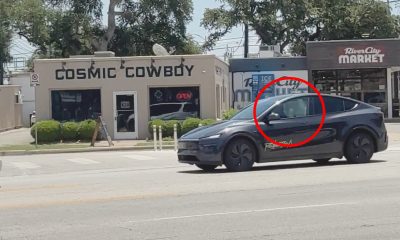
 Elon Musk2 weeks ago
Elon Musk2 weeks agoTesla Robotaxis are becoming a common sight on Austin’s public roads
-

 Elon Musk2 weeks ago
Elon Musk2 weeks agoSpaceX President meets India Minister after Starlink approval
-

 Elon Musk2 weeks ago
Elon Musk2 weeks agoxAI’s Grok 3 partners with Oracle Cloud for corporate AI innovation










